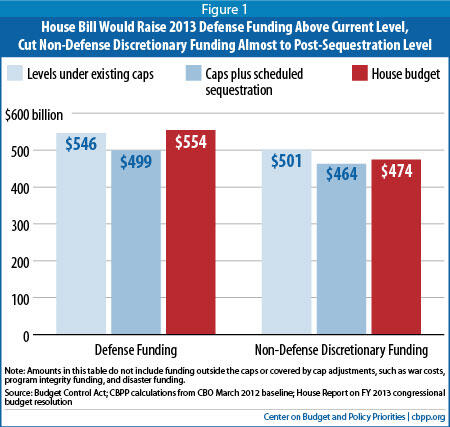A Closer Look at Chairman Ryan's "Sequestration" Proposal
End Notes
[1] For a broader examination of the Ryan proposal and the related “reconciliation” bill that the Committee also approved on May 7, see Robert Greenstein and Richard Kogan, “House Budget Bills Would Target Programs for Lower-Income Families While Breaking Last Summer’s Bipartisan Deal,” Center on Budget and Policy Priorities, revised May 8, 2012, https://www.cbpp.org/cms/index.cfm?fa=view&id=3767.
[2] In previous analyses, we have written that the Ryan budget plan would reduce total discretionary funding by $30 billion, rather than the $19 billion discussed in this analysis. We used the $30 billion figure because the Ryan budget plan would have disallowed certain upward cap “adjustments” that are permitted under the Budget Control Act, such as in the case of national disasters. The Budget Committee’s report on the Ryan budget plan stated, “The budget assumes that any future disaster-relief-designated spending relief will be fully offset within the discretionary levels provided in this resolution.” As David Rogers of Politico has reported, however, this aspect of the Ryan budget plan triggered conflict between the Budget and Appropriations Committees, and the Appropriations Committee ultimately prevailed. See David Rogers, “GOP returns to disaster issue,” http://www.politico.com/news/stories/0312/74504.html, and “House crushes budget compromise,” http://www.politico.com/news/stories/0312/74619.html. H.R. 4966 keeps these upward disaster adjustments in place, and so confirms the success of the Appropriations Committee on this matter. The new Ryan bill is precisely consistent with the House-passed budget resolution as subsequently modified de facto to allow these upward adjustments.
[3] For a detailed description of how sequestration will work, see Richard Kogan, “How the Across-The-Board Cuts in the Budget Control Act Will Work,” Center on Budget and Policy Priorities,revised April 27, 2012,https://www.cbpp.org/sites/default/files/atoms/files/12-2-11bud2.pdf
.[4] Since a budget resolution is not a law, separate legislation is needed to alter the caps that the BCA set for 2013 and to cancel the sequestration of discretionary programs scheduled for 2013. That is what H.R. 4966 does. The sequestration also makes automatic cuts to three tiny mandatory funding streams in the defense budget function; the Ryan bill would cancel those cuts in 2013. Note also that the mere enactment of alternative savings does not by itself reduce or cancel that scheduled sequestration, because it was designed to be a guaranteed penalty if the supercommittee failed.
[5] In this analysis, we compare the level of funding allowed under the discretionary caps with the level of funding that will be available after the scheduled sequestration occurs. To make this a valid apples-to-apples comparison, we exclude war funding, which is not subject to the caps but is subject to sequestration. That is, we compare the level of funding that is subject to the caps with the level of that funding – funding other than for the war – after the scheduled sequestration. (Note that while most war funding occurs in the defense category, a small amount occurs in international affairs, which is part of the non-defense category.)
[6] The President does propose to reclassify $4.2 billion of discretionary transportation funding as mandatory, placing it within a proposed, mandatory successor to the Highway Trust Fund. This action, if approved by Congress, would decrease the applicable discretionary cap by $4.2 billion; that action would be a reclassification, not a program cut. The Ryan budget, in contrast, requires $19 billion in program cuts in order to live within its reduced discretionary cap. Since the President’s proposed reclassification is not a program cut, we do not reflect it in Table 1.
[7] See Richard Kogan and Robert Greenstein, “The False Choice of National Defense Versus Helping the Poor,” Center on Budget and Policy Priorities, April 20, 2012,https://www.cbpp.org/sites/default/files/atoms/files/4-20-12bud.pdf
.
